- HOME
- Ecommerce
- Building Your Ecommerce Website
- Writing a Returns & Refunds Policy that Gets You Conversions and Customer Loyalty
Writing a Returns & Refunds Policy that Gets You Conversions and Customer Loyalty
- 12 Mins Read
- Posted on March 5, 2019
- Last Updated on October 8, 2024
- By Lauren
We know: Returns and refunds may be one aspect of running an ecommerce business that you really don’t want to think about. They can be draining both emotionally and financially. You love and believe in your product; why don’t all of your customers feel the same way?
Well, first, it’s worth remembering that returns are simply the nature of the beast. As we mentioned earlier, around 30% of products ordered online get returned: That’s more than three times as many as are returned to brick-and-mortar stores. Your customers will want to return or exchange items for any number of reasons that you shouldn’t take personally: They received a damaged product; they ordered the wrong item; the item doesn’t fit; they ordered multiple sizes with the intention of keeping the one that fit best; they received it as a gift but aren’t as enthralled by it as the friend who bought it for them; and so on. Of course, return patterns can teach you a lot about where to make your offering better; but a returned item doesn’t necessarily signal distaste for your product at all.
Second—and here’s where it gets exciting—it’s possible to put a Returns & Refunds policy in place that actually drives conversions. (Yes; you heard that right.) Read on to find out how that could possibly be true—and how to craft a policy that will ultimately win you customer loyalty.
Why Should You Have a Returns & Refunds Policy?
In some ways, the answer to this question might seem obvious. One of the biggest differences between a brick-and-mortar store and an ecommerce shop, after all, is in product experience: Customers can’t see, touch, feel, hold, or try on an item before they buy it. As such, purchase is perceived as a risk. One of the best ways to compensate for that risk is to offer a return policy that helps overcome that psychological barrier.
Indeed, studies have shown that as many as 79% of online shoppers check a shop’s return policies before they purchase a product. Not having one in place means you miss the chance to convince nearly 80% of your prospects that they have nothing (or little) to lose by making that purchase. And even if you can’t offer the most compelling returns policy, this is another moment to build trust through honesty.
There’s also a legal case for having a returns policy. In many countries, merchants are required by law to accept returns on products within a reasonable timeframe. In the United States, for example, retailers must accept returns on defective items; and the Federal Trade Commission’s “Cooling-Off Rule” gives buyers three days to cancel purchases of $25 or more. (There are also separate state laws about customer returns.) In the European Union, on the other hand, consumer law states that ecommerce customers “have the right to cancel and return [their] order[s] within 14 days, for any reason and with no justification.” According to Australian consumer law, customers aren’t required to return products in their original packaging to receive a refund. And so on. Reminding prospects that you know the laws in your jurisdiction legitimizes you.
(That’s a hint, by the way, to know the laws that govern return policies in the territory you do business in! If you can, seek out competent legal advice to ensure you’re operating within state and country regulations. Indeed, you should get legal advice on all your ecommerce policies—especially your privacy policy and your Terms & Conditions.)
Finally, you’ll want a system in place for that 30% of customers who do decide to return an item. Without one, you’ll be offering returns and exchanges on a case-by-case basis, confusing your customers and wasting employees’ precious time. Have an intentional set of standards to abide by. It’ll be good for everyone’s morale.
What to Include in Your Returns & Refunds Policy
In a moment, we’ll get to the best of the best practices, but for now, here are the basic elements you’ll need to cover for a comprehensive policy:
Timeframes
We say “timeframes” plural because there are (at least) three of them: how long a customer has to tell you that they want a refund or exchange; how long they have to ship the product back to you; and how long it will take to refund the money to their card, get them a store credit, or get the replacement product shipped out to them. Communicate all of these. 30 days is a typical ecommerce return period, though 60 and 90 days are common as well. Be clear about whether you mean the number of days from the date of shipping or the date of arrival. This will help you avoid conflict later.
Note that your timeframe doesn’t have to be the same for every product. If some of your merchandise goes out of season quickly, for instance, you don’t want to be stuck with products you can’t resell. You could also offer a phased system (returns within the first 30 days are eligible for a full refund, returns from 31-45 days are only eligible for store credit OR a 75% refund, and so on). These decisions will hinge upon your financial situation and the law. What’s important is your clarity about what they are.
Product condition
Do prepackaged items still have to be in their original, sealed packaging, or are you willing to take them back if they’ve been unwrapped? What if the product doesn’t arrive broken, but the customer quickly breaks it? Do the tags still have to be on, can the item be lightly worn, or—like Athleta—are you willing to accept sweaty clothes back with a “GIVE-IT-A-WORKOUT” guarantee? (Note how the requirements differ across Gap brands):
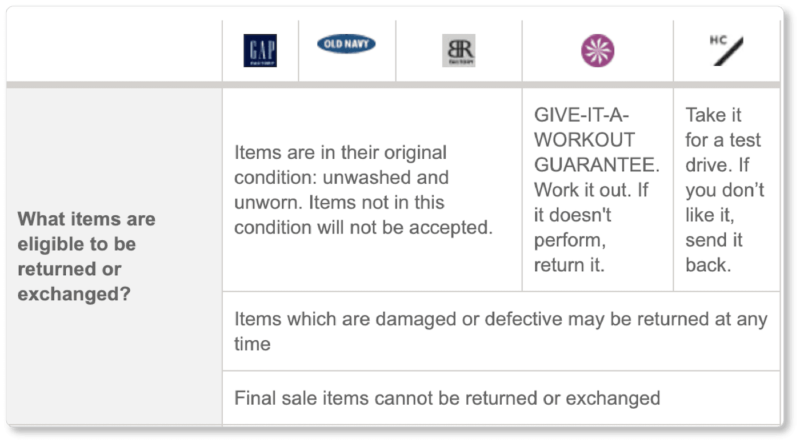
And so on. Explicitly define the condition a product can be legitimately returned in. Failing to include this exposes you to the risk of customers misusing your policy.
Other return requirements
Will you accept returns without receipts or packing slips? What about exchanges without receipts or packing slips? What if they’re gift returns and so receipts aren’t available? Are any products (clearance merchandise or bespoke items, for example) “final sale”? Do customers have to contact you to get an authorization number before they send their item back? (If you’re using Commerce Plus, you’ll have a Return Merchandize Authorization (RMA) system already integrated into your ecommerce site.) Any other exceptions? Any other requirements?
Returns or Exchanges, Refunds or Credit
Clarify exactly how customers will get compensated when they return a product. Of course, many of your customers will want the option of a full refund; but (unless you’re bound by law), you have alternatives if margins are too slim to sustain that. If you can’t please every customer, at least avoid confusion: Can certain items only be exchanged and not returned? If the product is broken or defective, do you only offer a replacement, not a refund? If you can only offer store credit for certain types of returns, to which products does that apply? And if the customer prefers to exchange for a different product, but there’s a price difference, how will you handle that?
All associated return fees
Do you cover the cost of return shipping, or does your customer? Does it matter whether the product is defective, you sent the wrong item, or the customer just changed their mind? What about restocking fees? No customer will want to pay these fees; but better they know about them now than get a nasty surprise when it’s return time. (Remember, angry customers are armed with a powerful weapon: the social media post. Which ultimately means you’re damaging your relationship with more than one consumer if you don’t disclose these matters pre-purchase.)
Your business’ contact information
Close your Returns & Refunds policy with your contact information so customers can reach you if they have further questions (and then bereachable!). As you field these questions, note them. If you find yourself answering the same question more than once, it’s worth considering adding the answer to your policy.
How to Write a Strong Returns & Refunds Policy
Now you know the basics of what should go into a written return policy. But if you want it to actually generate sales for you, the policy has to be appealing. So how do you make your returns policy as conversion-friendly as possible? We’re glad you asked:
Take care with your language
We mean at least three things by this. Your language should be:
1. Simple. Write like you speak. Avoid acronyms (“SKU,” “RMA”) and legalese (“sole discretion”). Otherwise your policy might lead to more phonecalls for clarification than you’re willing to take. Simply let your customers know that—whatever their reasons for wanting a return—you want to make it right. Perhaps you even offer an infographic or a video, like Evolve Fit Wear does:
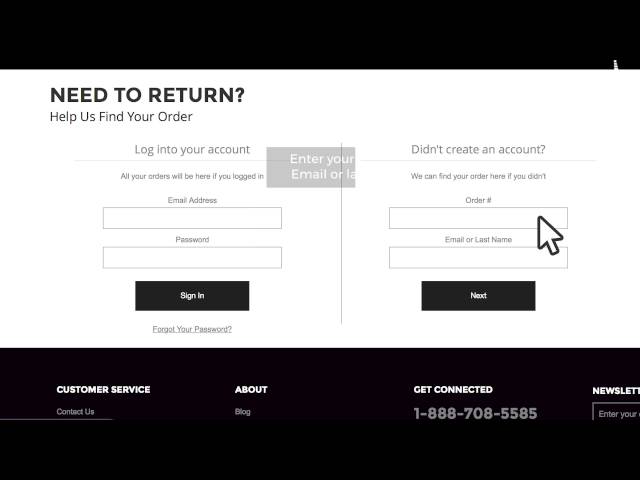
Remember, you’re dealing with potentially frustrated customers, so be friendly and conversational—while maintaining your brand voice. Like any piece of website copy, your returns policy is an extension of your business. Treat it like one, in both attitude and tone.
2. Positive. We don’t have to tell you there’s a difference between saying “After 30 days, your item is ineligible for a refund” and “We will happily refund your item within the first 30 days of purchase.” Likewise, there’s a difference between “We will absolutely take back any unopened product” and “Opened products cannot be returned”—even though both sentences essentially say the same thing. Just because customers want to return something doesn’t mean you should barrage them with negativity! Opt for “yes” rather than “no” sentences. And while we’re at it: Don’t tell the customer what they “must” do or are “required” to do, or what you “are not responsible for.” Your customers don’t want mandates; and they don’t want to hear you absolve yourself of responsibility.
3. Unambiguous. When you say you accept all returned items “within 30 days,” you mean 30 days from when? Or here’s an example from Best Buy’s Returns & Exchanges policy: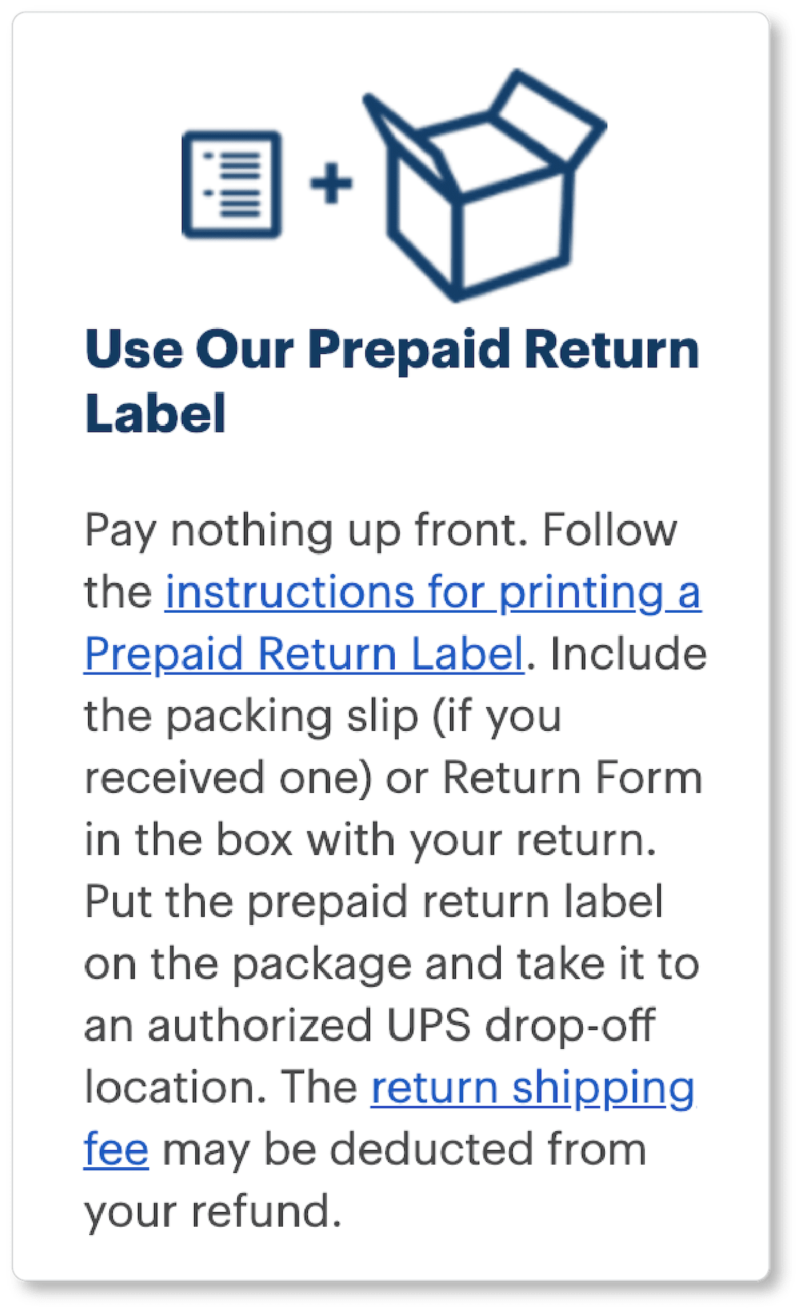
“The return shipping fee maybe deducted” from the refund? Well, will it be deducted, or won’t it? Who decides, and on what basis? Don’t leave your customers wondering. Go carefully over each sentence you write and ensure it can only be interpreted in one way.
Offer free returns
We know: “Free returns” certainly aren’t free for you; and you may not be able to crunch the numbers to make it work. But it’s a delight for your customers; and it’s worth considering what free returns could mean for your business over the long term—even if it hurts your profit margins early on. We could cite the statistics here:
- Free returns is the #1 element of a “best returns experience”
- 79% of consumers want free return shipping
- Free shipping and free returns are the two most important factors encouraging online purchases
- Free returns can boost a store’s online purchases by 357%
Or you could just look to Zappos, which has famously made free shipping and returns a cornerstone of its brand position… and whose best customers also have the highest return rates. Craig Adkins, Zappos’ Head of Fulfillment, notes that those high-returns customers “are also the ones that spend the most money with us and are our most profitable customers.”
One suggestion? Try free return shipping for the first 6-9 months you’re in business and see how it goes. If this just isn’t possible, consider offering it with a minimum order value, or during high-volume sales periods (like the holidays) to offset the financial impact. You might be surprised at your ROI.
Adopt a liberal timeframe
This might seem like a counter-intuitive strategy, too—and again, if your offering is seasonal or dependent upon changing trends, it might not be for you. But studies have shown that extending the return period leads not only to more returns; it also leads to more sales. (After all, more than half of online shoppers say they avoid shopping with retailers that have strict returns policies in place.) The leaders of a study published in the Journal of Retailing note that lengthening the timeframe for returns means customers feel less pressure to decide: “If you offer people more time, they’re more likely to forget or more likely to postpone making a decision.” This can ultimately lead to a decrease in return rate, thanks to what’s known as the “endowment effect”: the tendency to ascribe greater value to things we have ownership of.
The endowment effect is probably why the mattress company Hyphen can maintain such a generous returns policy (if “you’ve slept on it for less than 100 nights”), and still stay in business:

That doesn’t mean you should go overboard; even L.L. Bean recently had to drop its famous lifetime return policy. But it’s worth testing 60 days, 90 days, or longer, until you find the optimal timeframe for your business. We wouldn’t be surprised if you see fewer returns as your timeframe becomes more liberal.
Pro tip: We’d especially recommend an extended timeframe for returns during the holiday season. For example, many people start shopping for Christmas in late November. You don’t want your timeframe to be expired before those gifts are even unwrapped!
Clearly and simply describe the returns process
It shouldn’t take your customer more than a minute or two to understand how your returns process works. You’ve been on the other side; you know how useful numbered lists and visuals are. Make use of personal experience. Here’s how the shoe company Suavs does it:
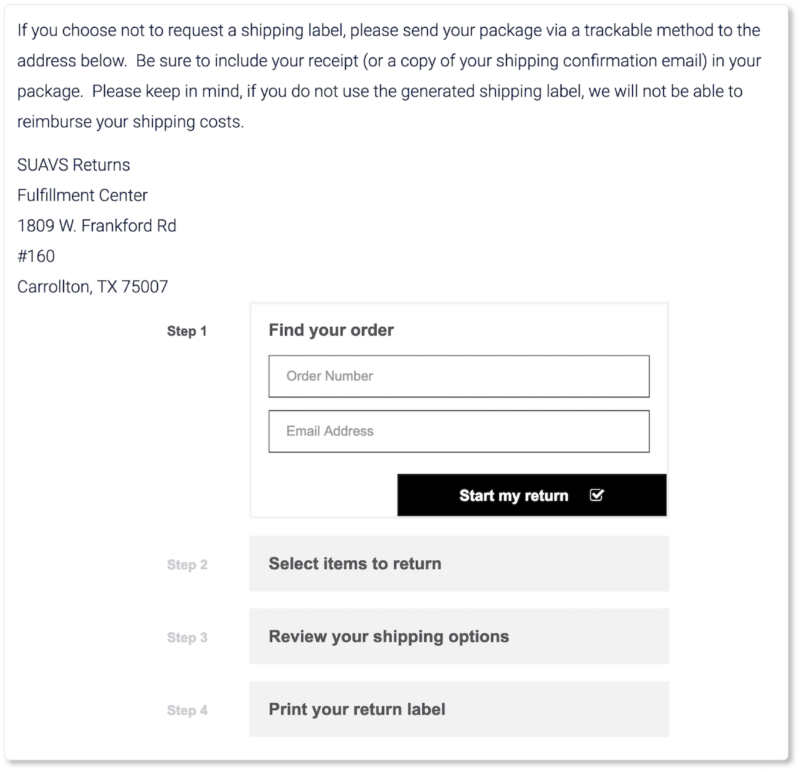
Suavs’ instructions are listed in clear, chronological steps. What’s more, users can initiate the exchange directly through the company’s website, making the whole process feel seamless and under control from a UX perspective. Such integrations and automations are a win-win: Studies have shown that, across industries, 81% of customers attempt to take care of matters themselves before reaching out to a business. Letting them complete the entire returns process without contacting you aligns with their preferences.
Make your policy readily available, everywhere
You already know that your returns policy (like your shipping policy) should be featured on your website—at least through a link in your footer so it’s accessible from every page. Don’t hide it under a link called “Legal”; call it what it is and link directly to it. Users should be able to get there in a single click—after all, if they can’t find it, you might lose them. Here’s the footer on Suavs’ website:
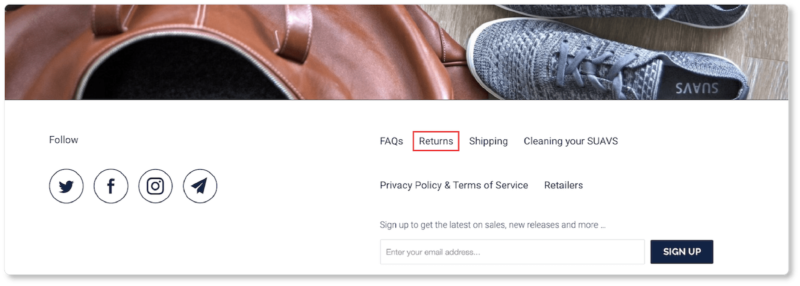
But go further than that. Remind visitors on your homepage and product pages. Place a link to the policy under your “Add to Cart” CTA. Put it on your FAQ page. Include it in purchase confirmation emails. Ship a note with their items that reiterates your policy and returns process (or print it directly on your packing slips), along with the contact information for your support team if an issue arises. Promote it as a graphic in your social media channels—especially if it’s a particularly generous policy, and especially during the holidays. Holiday shoppers will be all the more likely to purchase from you if they know their gift recipients will experience hassle-free returns. Customer service—so they say—is the new marketing.
While it might seem like ubiquitously advertising a returns policy only “reminds” customers that they can send back your product, that’s not the psychological reality.
Rather, it “reminds” them that you stand behind your product and you’ve got their back if they’re dissatisfied or change their minds. They’ll feel all the more certain about purchasing from you again the next time around. (It also makes it more difficult for customers to claim “they never saw your returns policy.”)
Own it
By “owning it,” we mean two things:
1) Don’t copy and paste: Literally write your own returns policy. Remember, your policy is heavily dependent upon your product, your industry, your customer demographic, your business margins, and your company philosophy: It’s hardly a one-size-fits all document. So as tempting as it might be to turn to the “return policy generators” out there, we’d advise against it. It’ll sound generic; it won’t entail a strategy that fits your business; and the copy-and-paste strategy is never good for search engine optimization (SEO). Think about best practices, strategies, and policies for your store—in light of your competition—and go from there.
2) Make sure your staff knows your policy inside-out. An informed staff will offer a consistent returns experience. They won’t waste time figuring out how to handle the specifics; and you won’t have to deal with unsettling conversations between employees and customers.
Characteristics of a Stellar Returns Experience
For now, you’re just writing your policy; we won’t delve into the details of a customer-centric returns experience until later. But it is worth noting, here, the othertop elements of a “best returns experience” (remember, the top element is free return shipping): a hassle-free policy (51% of respondents), easy-to-print return labels (44% of respondents), and having the return shipping label already in the box (40% of respondents). Offering these things can turn a dreaded element of ecommerce into an opportunity that generates customer loyalty—even when your product wasn’t a perfect fit.
If you treat returns as an opportunity to transform a poor customer experience into one in which you get to flex both your sympathy and logistics muscles, you can turn the entire experience into a brand asset. Indeed, both your returns process and the policy itself can sell your business for you.
Congratulations! You’ve now written two of the four legal documents you’ll need for your ecommerce website. Before we discuss your privacy policy, let’s set up analytics for your store, so you can understand exactly what information you’re collecting from visitors and customers. In the next section, we’ll cover ecommerce analytics and the website metrics you should be paying attention to.